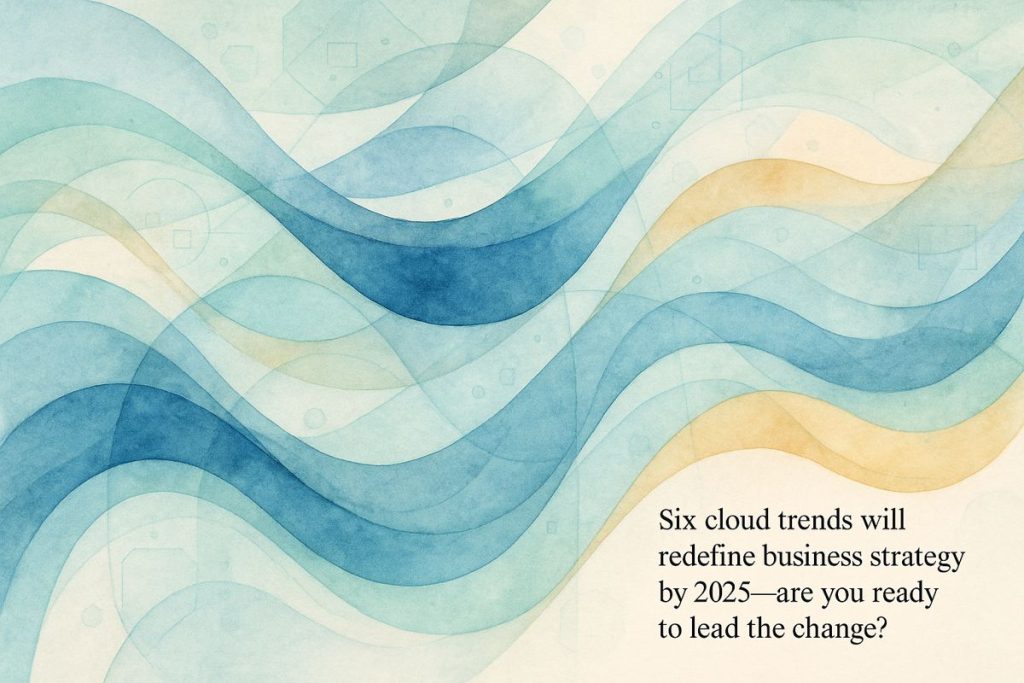In 2025, cloud computing is changing fast with six big trends. Many companies are unhappy with the cloud because of high costs and unmet promises. AI and machine learning are making cloud use grow quickly, but they also create new challenges. More businesses are using a mix of different clouds for flexibility and safety. Focus is growing on special clouds for certain industries, being eco-friendly, and keeping control of digital data.
What are Gartner’s six key trends transforming cloud computing in 2025?
Gartner identifies six trends transforming cloud computing in 2025:
1. Rising cloud dissatisfaction due to unmet expectations and cost issues
2. AI/ML driving significant cloud adoption
3. Increasing migration to hybrid and multicloud strategies
4. Growth of industry-specific cloud platforms
5. Emphasis on sustainability in cloud operations
6. Heightened focus on digital sovereignty.
Cloud computing. The phrase alone smells faintly of ozone and the whir of a thousand fans—data centers humming like the innards of some digital cathedral. If you’re like me, you sometimes pause, mug in hand, and wonder: is this whole cloud thing really as transformative as we say, or are we just caught in a vaporous cycle of hype and disappointment? According to Gartner (yes, that Gartner), the answer—as of 2025—is decidedly nuanced. Their latest analysis sketches out six tectonic trends poised to rattle, reshape, and, in a few cases, redeem cloud computing for the next wave of technology leaders.
The names on this stage—Salesforce, SAP, Snowflake—aren’t just playing supporting roles; they’re scriptwriters, improvisers, and maybe even the lighting crew. If these companies sound familiar, it’s because they’ve already weathered more pivots than a caffeine-fueled product manager at a hackathon. I suppose it’s only right that we look past the marketing haze to the specifics: what’s shifting, who’s steering, and which pitfalls are waiting for the unsuspecting CIO?
Let’s dig in, one trend at a time, and see what the forecast really holds.
The Growing Pains: Cloud Dissatisfaction Emerges
Here’s the first shockwave: by 2028, Gartner predicts that a full 25% of organizations will be genuinely dissatisfied with their cloud experience. If you’re squinting at your budget spreadsheet and muttering “ugh, not again,” you’re not alone. Discontent arises not from some cosmic disappointment, but from real, measurable misalignments: unclear expectations at kickoff, lack of tailored cloud migration plans, and (oh yes) costs spiraling out like fractals.
I recall a project from 2022—client unnamed, but let’s just say their CTO had the steely glare of a chess grandmaster. They’d been promised nirvana; what they got was more like an overcooked casserole. The turning point? When they realized half their workloads were idling in hyperscale purgatory, racking up charges. Frustration gave way to a sort of grim amusement. The lesson: if you’re going to migrate, migrate with your eyes wide open and your governance toolkit in hand.
It sounds so simple, doesn’t it? But as the proverb goes: “The cloud giveth, and the cloud taketh away.” And if you’re thinking, “Is this just a phase?”—well, I had to stop and ask myself the same thing. History suggests the organizations that thrive are those that communicate the limits and benefits of the cloud clearly, monitor costs religiously (maybe even obsessively), and iterate their strategies without ego.
AI/ML: The Catalyst, Not the Panacea
Artificial intelligence and machine learning—those twin titans—are fueling a renaissance in cloud adoption. It’s not all magic, of course; there’s the palpable grind of GPU clusters and the hiss of hyperspectral data pipelines. Gartner reports that by 2025, the most significant uptick in cloud spend will be driven by AI workloads, especially generative AI (GenAI) models that require compute power on a scale that’d make even Alan Turing raise an eyebrow.
Platforms like Snowflake and SAP are morphing into marketplaces for AI-powered applications, each promising to automate everything from healthcare record analysis to the arcane art of responding to construction RFPs. (Yes, even the dullest industries are getting their algorithmic glow-up.) I remember testing out a GenAI tool last winter—the thing wrote better meeting minutes than I ever could, but it also hallucinated a quarterly report that never existed. There’s a lesson in there somewhere about machine “creativity,” but I digress…
Still, one looming challenge remains: data synchronization across hybrid and multi-cloud environments. Data scattered like confetti across Azure, AWS, and private clouds? Not exactly a recipe for actionable AI. Gartner calls it an “urgent” obstacle, and they’re not wrong. Until those pipes are truly seamless, expect a few Frankenstein deployments—part genius, part glitch. If you want the technical details and numbers behind the surge, check Gartner’s own trend analysis.
Multicloud and Cross-Cloud: The New Operating Reality
By 2027, Gartner says 90% of organizations will have embraced hybrid or multicloud strategies. That’s not a typo. One cloud to rule them all? More like a palimpsest of platforms—public, private, edge—stitched together to meet a kaleidoscope of regulatory, performance, and economic needs. SAP and Salesforce are rolling out cross-cloud architectures with the ambition of a seasoned chess player, embracing interoperability as the new gold standard.
Multicloud isn’t just a buzzword; it’s a survival mechanism for enterprises that can’t bet the farm on any single hyperscaler. I once saw a team build an entire disaster recovery plan around three clouds and one ancient colo server (don’t ask). Their reasoning: redundancy, compliance, and the vague dread of vendor lock-in. It smelled faintly of burnt coffee and desperation, but it worked.
Here’s a rhetorical question for you: is this complexity inevitable, or are we making it up as we go along? Sometimes I’m not sure. What’s clear is that the winners will be those who master orchestration—knitting together disparate services without letting data sovereignty or latency slip through the cracks.
Industry Clouds, Sustainability, and Digital Sovereignty: The Next Frontiers
Industry-specific cloud platforms are the hot new thing—custom-tailored, compliance-laden, and loaded with sector-specific
